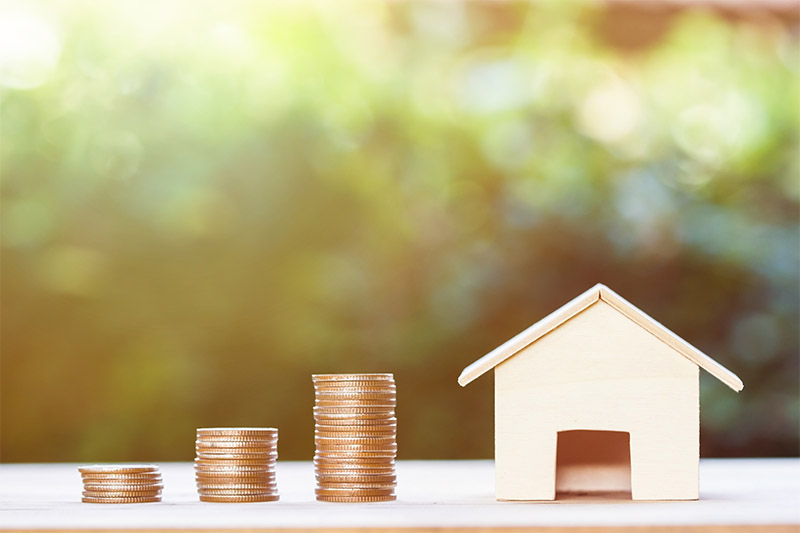Why Spring is a Prime Time for Real Estate Spring consistently ranks as one of…
How Much Equity Do I Have in My Home?
Property Outright: Understanding Home Equity
Home ownership is an admirable goal and one that many Americans work towards throughout their lives. Which leads to the question: How Much of My Home’s Equity Do I Own? You may think that once you sign on the dotted line and have the keys to your own home, you are a home owner. That is only partially true. While you can claim home owner status, if you have a mortgage you only own a portion of your home’s equity, which is the difference between your home’s current value and the outstanding mortgage balance. The next major milestone to reach is paying off that loan and owning your home outright.
What is home equity?
Every time that you make a mortgage payment, only part of your payment goes towards the principal value of the loan—what you borrowed to purchase the home. The rest goes towards interest (what you pay the bank for loaning you the money), taxes, and insurance.
Equity is the amount of ownership that you have in your home, or the amount of principal that you have paid off. If you have paid down half of the principal, you have 50% equity. Once you have paid off the loan entirely, you have 100% equity—also known as owning your home free and clear: congratulations! Finding a reliable home equity lender is crucial when considering options to leverage your home’s equity.
Maintaining a specific loan-to-value ratio is important in the context of home equity, as it can impact fees for investment property loans and the elimination of private mortgage insurance (PMI) for homeowners.
After following the step-by-step guide, it’s important to understand that lenders assess your debt-to-income ratio to determine if you have sufficient equity and financial stability to obtain a home equity loan.
How Home Equity Works
Home equity is the difference between the current value of your home and the outstanding balance of your mortgage. As you make mortgage payments, you build equity in your home. The amount of equity in your home can also increase if the value of your home rises. Home improvements, such as adding a room or remodeling a kitchen, can also increase your home’s value and your equity. Property values can increase over time, but this is not guaranteed and depends on your local market and the overall economy.
Calculating Your Home Equity
Calculating your home equity is a straightforward process that involves determining the current value of your home and subtracting the outstanding balance of your mortgage. Here’s a step-by-step guide to help you calculate your home equity:
- Determine the current value of your home: You can use online home value estimators, such as Zillow or Redfin, to get an estimate of your home’s value. Alternatively, you can hire a local licensed appraiser to provide a more accurate estimate.
- Determine the outstanding balance of your mortgage: Check your latest mortgage statement or contact your lender to find out the current balance of your mortgage.
- Subtract the outstanding balance from the current value: This will give you the total amount of equity in your home.
When calculating your home equity, it’s important to consider the impact of conventional loans, especially if you have private mortgage insurance (PMI) due to a lower down payment.
For example, if your home’s current market value is $400,000 and you still owe $200,000 on your mortgage, your home equity is $200,000 (or 50%).
How Much Equity Do I Have in My Home?
To calculate how much equity you have in your home, subtract the outstanding balance of your mortgage from the current value of your home. You can use an online home value estimator, such as Zillow or Redfin, to get an estimate of your home’s value. A local licensed appraiser can provide a more accurate estimate of your home’s value. For example, if your home’s current market value is $400,000 and you still owe $200,000 on your mortgage, your home equity is $200,000 (or 50%).
How can I increase my equity and how much equity do I need?
The simplest way to increase your equity is to pay off your mortgage. Your lender set that up when they determined your monthly payments. Every month that you pay your mortgage, you have a little bit more equity. Additionally, your initial down payment contributes significantly to your home equity, establishing how much of the home’s value you own outright compared to the lender. But what can you do to accelerate the process?
Making extra mortgage payments towards the principal balance can go a long way to building equity, particularly if you can do it early. The first few years of a traditional 30-year mortgage have the buyer paying a large amount of interest each month, with only a small portion going towards principal. Making extra payments can knock months or even years off of your mortgage. While making extra mortgage payments is one way to build equity, some homeowners also consider personal loans, although they typically come with higher interest rates compared to home equity loans.
Building equity in your home will get you to that coveted mortgage-free home owner status.
Using Your Home Equity Line
There are several ways to use your home equity, each with its own benefits and considerations:
- Home Equity Loan: A home equity loan is a second mortgage that allows you to borrow a lump sum of money using your home’s equity as collateral. You can use the funds for any purpose, such as paying off debt, financing home improvements, or covering unexpected expenses.
- Home Equity Line of Credit (HELOC): A HELOC is a revolving line of credit that allows you to borrow and repay funds as needed. You can use the funds for any purpose, and the interest rate is often lower than other types of credit.
- Cash-Out Refinance: A cash-out refinance involves refinancing your existing mortgage and taking out a new loan for more than you owe on your current mortgage. Cash out refinancing remains a viable and often more affordable choice for homeowners looking to leverage their equity, despite rising rates. You can use the excess funds for any purpose, such as paying off debt or financing home improvements.
- Home Equity Line: A home equity line is a type of loan that allows you to borrow funds using your home’s equity as collateral. You can use the funds for any purpose, and the interest rate is often lower than other types of credit.
It’s essential to consider the tax benefits of using your home equity. The interest on home equity loans and lines of credit may be tax-deductible, which can help reduce your taxable income.
Using Home Equity to Eliminate PMI
Private mortgage insurance (PMI) is a monthly charge that protects the lender in case you default on your mortgage. You can get rid of PMI once you reach 20% equity in your home. Most lenders automatically cancel PMI when you reach 22% equity. To eliminate PMI, you can refinance your mortgage or make extra mortgage payments to build up your equity stake. You can also consider a home equity loan or line of credit to tap into your existing equity and use the funds to pay off your mortgage and eliminate PMI.
Risks and Considerations
While using your home equity can be a convenient way to access funds, there are several risks and considerations to keep in mind:
- Risk of Foreclosure: If you’re unable to repay your home equity loan or line of credit, you risk losing your home to foreclosure.
- Increased Debt: Using your home equity can increase your debt burden, which can be challenging to manage.
- Variable Interest Rates: HELOCs and home equity lines often have variable interest rates, which can increase over time.
- Fees and Charges: Home equity loans and lines of credit often come with fees and charges, such as origination fees, closing costs, and annual fees.
- Impact on Credit Score: Missing payments or defaulting on a home equity loan or line of credit can negatively impact your credit score.
To minimize the risks, it’s essential to:
- Borrow Only What You Need: Avoid borrowing more than you need, as this can increase your debt burden.
- Choose a Fixed Interest Rate: Consider choosing a fixed interest rate to avoid the risk of variable interest rates.
- Make Timely Payments: Make sure to make timely payments to avoid late fees and negative impacts on your credit score.
- Consider Alternative Options: Consider alternative options, such as balance transfer credit cards or debt consolidation loans, before using your home equity.
By understanding the risks and considerations, you can make informed decisions about using your home equity and avoid potential pitfalls.
What is a home equity loan?
Home Equity Lines of Credit (HELOCs)
A home equity line of credit (HELOC) is a type of loan that allows you to borrow against the equity in your home. A HELOC is a revolving line of credit, meaning you can borrow and repay funds as needed during the draw period, usually up to 10 years. After the draw period ends, you’ll enter a repayment period, usually 10 to 20 years, during which you’ll make monthly payments to pay off the loan. HELOCs often have variable interest rates, which can increase or decrease over time. You can use a HELOC to finance large expenses, such as home repairs or college tuition, or to consolidate debt.
Cash-Out Refinance
A cash-out refinance is a type of mortgage refinance that allows you to tap into the equity in your home and receive a lump sum of cash. With a cash-out refinance, you’ll refinance your existing mortgage and take out a new loan for a higher amount than you currently owe. You’ll pocket the difference in cash, which you can use to pay off debt, finance home improvements, or invest in other assets. Cash-out refinances often have lower interest rates than other types of loans, but you’ll need to consider the closing costs and fees associated with refinancing your mortgage. Additionally, you’ll need to ensure that you have enough equity in your home to qualify for a cash-out refinance, usually 20% or more.





